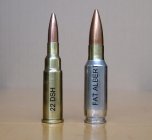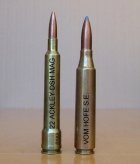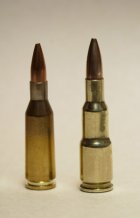I’m taking a chance in showing these two cartridges because I think at least one of the originators is till alive. So, if he’s reading this I hope he is not offended. I don’t mean it to be.
The lowliest benchrest shooter on the line, the guy who always finishes last, is still a better shooter/handloader/ballistician than the best of the best over on the public range. But nobody can be smart all the time. All of us have done things that border on being foolish or, worse yet, dangerous. Being one who has done both, usually at the same time, I’m not here to embarrass those responsible for todays two competition cartridges but it’s always better to tell of others’ mistakes rather than your own.
Many shooters have at least one odd-looking, even bizarre, “joke†cartridge that they enjoy showing to any unsuspecting novice who is unfortunate enough to be in the vicinity. But the two that I will describe and show are for-real benchrest cartridges that were actually used in competition. I like to call them the .22 IT SEEMED LIKE A GOOD IDEA AT THE TIME and the .30 HOLD MY BEER AND WATCH THIS.
22 DSH - Based on drastically reformed and shortened 30-30 brass, this 22 caliber double shoulder wonder was supposed to be the ultimate in efficiency and, therefore, accuracy. It may have even used a duplex powder charge for all I know. The fact that it made only a brief appearance and then disappeared should tell us something.
30 FAT ALBERT - While usually found in shortened 284W brass, this specimen is made from a Federal 308W nickeled case fire-formed in the much larger Fat Albert chamber. It’s not an isolated example because I have a whole supply of others just like it. Most everyone will agree that the .035" expansion at the case head is far too much for a cartridge generating more than 50,000 psi pressure. The fact that the shooter apparently survived attests not to his good judgement but to the strength of the brass and rifle.
I know, I know, there are some of you out there who will say that these cartridges are neither foolish nor dangerous. I'd like to hear your arguements for the defense.
The lowliest benchrest shooter on the line, the guy who always finishes last, is still a better shooter/handloader/ballistician than the best of the best over on the public range. But nobody can be smart all the time. All of us have done things that border on being foolish or, worse yet, dangerous. Being one who has done both, usually at the same time, I’m not here to embarrass those responsible for todays two competition cartridges but it’s always better to tell of others’ mistakes rather than your own.
Many shooters have at least one odd-looking, even bizarre, “joke†cartridge that they enjoy showing to any unsuspecting novice who is unfortunate enough to be in the vicinity. But the two that I will describe and show are for-real benchrest cartridges that were actually used in competition. I like to call them the .22 IT SEEMED LIKE A GOOD IDEA AT THE TIME and the .30 HOLD MY BEER AND WATCH THIS.
22 DSH - Based on drastically reformed and shortened 30-30 brass, this 22 caliber double shoulder wonder was supposed to be the ultimate in efficiency and, therefore, accuracy. It may have even used a duplex powder charge for all I know. The fact that it made only a brief appearance and then disappeared should tell us something.
30 FAT ALBERT - While usually found in shortened 284W brass, this specimen is made from a Federal 308W nickeled case fire-formed in the much larger Fat Albert chamber. It’s not an isolated example because I have a whole supply of others just like it. Most everyone will agree that the .035" expansion at the case head is far too much for a cartridge generating more than 50,000 psi pressure. The fact that the shooter apparently survived attests not to his good judgement but to the strength of the brass and rifle.
I know, I know, there are some of you out there who will say that these cartridges are neither foolish nor dangerous. I'd like to hear your arguements for the defense.














